Can't have the 'games' without the 'video'...
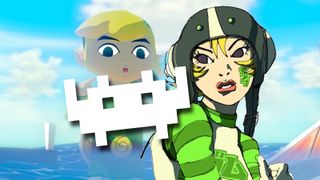
Not even the strangest-smelling games journalists are asking 'how many floating points' a game has any more. Obviously it depends how many you score (fnar), but I am so pleased to say that we've all got past the stage of citing polygon counts when judging a game's graphical merits. Pretty much anything you can imagine can now be drawn by modern consoles in terms of computational oomph, so now it's mostly down to artistic expression as to whether a game looks good or not.
But looking back over gaming's history, even when things weren't so easy, it was those who tried something a bit different who managed to make their games stand out. And so entire art styles were born. Sometimes through technical necessity, other times through a deliberate attempt to shun progress. Fortunately that means I have a lot to talk about! So follow me into the gallery, if you please - let me show you some beautiful things...
Pixel Art (Space Invaders, 1978)

Look at that adorable little chap. There are only 44 white squares making up that image, yet I'm sure you said 'Space Invaders' in your mind as soon as you saw it. Back then, these tiles were simply the smallest level of detail the cripplingly low-resolution displays could handle. But even since video games have hit full HD (and beyond), some designers still choose to use 8-bit-styled artwork, deliberately restricting the resolution - and colour palettes - of their sprites so that they appear blocky and pixellated. Why? Because it looks cool, is easier to animate, and it looks cool. What more reasons do you need?
These days? Pixel art is extremely popular so it isn't hard to find examples. The wonderful 10,000,000 on iOS is a fine specimen, as is Fez.
Vector Graphics (Vectrex, 1982)
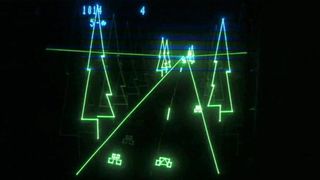
Vectrex was the first home console to display its games using vector graphics instead of rasterised imagery, such as sprites. If you listened in mathematics classes (which you totally did, right?) you might remember that vectors provide a method of calculating precise movements of points in space. Join those points up with lovely shiny lines and what have you got? Wireframe 3D. Yep, Vectrex was a 3D console. And that meant exceptionally smooth animation because it didn't use animation frames at all. It used maths.
These days? Some games still borrow that vector style, like Geometry Wars 3: Dimensions. They've got a whole load of other stuff going on as well, but that clean, 'glowing lines' style still has an air of mystique.
Isometric 3D (Zaxxon, 1982)

This was absolutely on the bleeding edge of technology in January, 1982. Zaxxon employs an 'isometric' viewpoint that allows flat, 2D graphics to look like 3-dimensional images, simply by drawing them as if viewed from a slightly elevated vantage point. By having the ship pass behind some elements of the scenery, it is enough to fool the (admittedly foolish) eye into thinking it is viewing an actual 3D room through the screen. It isn't, of course. And we can see that now. But that effect must've been amazing if it was the first time you'd seen it, back in the days before your humble narrator was even born. Suddenly, games were starting to look real.
These days? Isometric graphics are still popular on iOS, but even now everything can be rendered in 3D, the viewpoint has been retained for strategy games. X-COM: Enemy Unknown is a prime example.
Rotoscoping (Karateka, 1984)

Rotoscoped graphics were all the rage back in the early 1990s, as they allowed for far more realistic character movement than had ever been seen before. Basically what you need to do to rotoscope a character is film someone acting out the gesture you require, such as jumping, or picking something up off the floor. Then you trace each frame and use your drawings in sequence to create a moving character. Jordan Mechner pioneered the use of rotoscoping in games, first with Karateka (pictured, above-left), but then most famously in Prince of Persia (also pictured, above-right). Out of this World and Flashback then picked up the rotoscoped baton and ran with it.
These days? Hotel Dusk: Room 215 on Nintendo DS uses rotoscoped graphics to create its smooth animations. But the technique has arguably been surpassed by true motion capture, which is why it's seldom used now.
Digitised graphics (Mortal Kombat, 1992)

In the early 1990s, everybody was still drawing their sprites by hand, placing each coloured pixel on a grid until they had drawn one frame of the character in question. So imagine the leap-forward when Mortal Kombat let you fight with REAL PEOPLE. Well, real photos of people. OK, real photos of people that were retouched by hand to make them look good at tiny resolutions. Yep. I'm sorry, but I have to say: to modern eyes, the effect looks awful, at least when it's moving. Back then, it was revolutionary.
These days? Not many games choose to use digitised sprites any more, because the most 'photorealistic' games use 3D to achieve their goals. Um... NBA Jam on Wii and iOS? Yep, sorry, pushing it a bit.
Flat-shaded 3D (Virtua Racing, 1992)
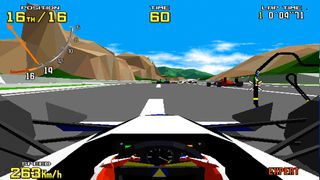
Flat-shaded 3D is something you would choose for its stylistic merits today, but it was born out of necessity. Before we had processor-intensive texture-mapped polygons (but after those lovely vector wireframes), some gaming hardware could 'flat-shade' polygons, with a process very similar to MS Paint's bucket tool, to fill in triangles. High tech, eh? Games like LHX Attack Chopper on Mega Drive and even some ZX Spectrum games like Hard Drivin' managed flat-shaded 3D visuals, but Virtua Racing was the first to do it at any kind of enjoyable speed. Light-sourced, too. Yum.
These days? Any flat-shaded game these days is being deliberately retro (which is cool because flat-shading is awesome). There are some flat-shaded scenes in Child of Eden on last-gen.
Film grain (Mickey Mania, 1994)
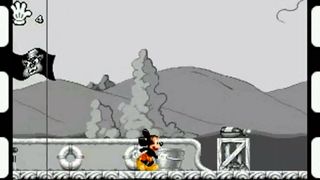
Film grain is often applied to horror games to make it look as though you're playing a horror movie. No, Mickey Mania isn't a horror game (but it is... scarily good. Aha!). And, to be clear, I am talking about the scratches and lines, not the film-strip effect on the sides up there. These deliberate imperfections are often combined with a vignette effect to darken the corners and edges of the display. Makes it less sterile, see? And just like a real film in a cinema. Only without the popcorn stuck to the seats or the people talking noisily behind you. Unless you have a really awful house.
These days? Most horror games employ some element of it. The Evil Within is a great example, but it's so pronounced it includes an option to reduce it or even turn if off completely. Hours of fuzz are probably not good for your eyes. 25 hours of psychological horror? Totally fine, obviously.
Pre-rendered backgrounds (Resident Evil, 1996)
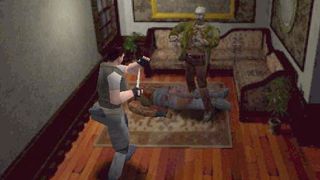
This was all the rage in the late 1990s. Polygonal 3D graphics were still in their infancy, but characters could have more detail if they were the only 3D objects being drawn. Stick them over a flat, pre-rendered (or even hand-drawn) background and you can have visuals far more detailed than the primitive tech of the day could ever draw by itself. Games like Alone in the Dark did it earlier than Resi, but Capcom's survival horror classic is the finest example of the art. Well, that and its immediate sequel.
These days? Well, there really isn't any need to do it any more! But there is an HD version of the Gamecube's Resident Evil remake coming soon, and that has pre-rendered backgrounds, so the style will live on. Can't see many native PS4 or Xbox One games going for it, though...
Cel shading (Jet Set Radio, 2000)

The idea of making games look like cartoons wasn't all that new when Jet Set Radio did it on Dreamcast, but it was the first to add black outlines to polygonal 3D to such incredible effect. Funnily enough, The Legend of Zelda: Wind Waker doesn't actually use black outlines at all, instead restricting the blending between light and shadow so that rounded 3D objects look like flat drawings of 2D objects. Which they would be anyway if you think about it. Hmmm...
These days? The likes of Ni No Kuni: Wrath of the White Witch use cel-shading on top of highly-detailed 3D character models to create visuals that really could be animated features. Of course the result is gorgeous. And Borderlands is another fine example of the (literal) art.
Photorealism (still waiting...)

Photorealism is a lot of graphical developers' ultimate goal. Computer graphics so realistic, they're indistinguishable from the real thing. Some angles of Gran Turismo 6 are approaching it. Heavy Rain had a crack (and failed) and new-gen consoles might approach it by the end of their life cycle. How? Well, ray-tracing actual beams of virtual light... look, actual photorealism where you simulate the real world is still beyond games consoles. So until then, look at Kevin Spacey and imagine he's the real Kevin Spacey. There ya go.
Right now? The sea in Grand Theft Auto 5. It's like the actual sea. But again, its people are nothing like actual people.
Is Minecraft its own art style?
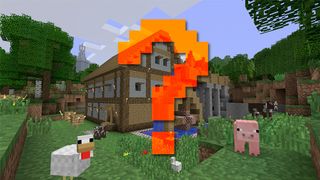
Now there's a question! The low-res textures on cubes make for a very distinct art style - which you could call 'Minecraft-style' - and one that is being copied by countless open-world resource-collecting games. But I would argue it's just pixel art applied to 3D. In spectacular, unmistakeable fashion, yes. But taking an existing idea and turning it into something new worked out 'pretty well' for Mojang. So! Got any more video game art styles that haven't been covered? Let everyone know in the comments.
And if you're looking for more, check out How to draw video game characters and A brief history of explosions in games.

